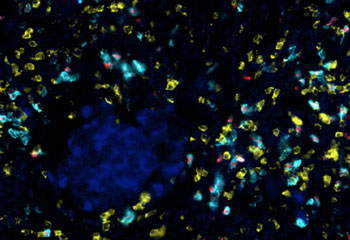‘Cutting the cable’ between CD8+ T and T regulatory cells enhances checkpoint immunotherapy
Discovery by UC Irvine-led team may offer new strategy for improving melanoma treatment

Irvine, Calif. — Checkpoint immunotherapy utilizing PD-1 blockade has become the standard of care for metastatic melanoma. While this treatment is effective in 40% of patients, the other 60% develop resistance, leading to tumor regrowth.
A multidisciplinary research team led by the University of California, Irvine has identified a new strategy that could enhance the therapeutic effectiveness of this therapy by targeting the communication between immune cells within the tumor.
In a study published in the prestigious journal Cancer Cell, researchers demonstrate that while PD-1 blockade activates a potent antitumor response in CD8+ T cells, it also promotes the accumulation of T regulatory cells, decreasing the immune response against the tumor. The activation of these competing signals — one set combatting the tumor and the other restraining the immune system — is likely a significant challenge in providing effective cancer treatment.
“Our latest research reveals that CD8+ T cells, activated by PD-1 blockade to target melanoma, also interact with T regulatory cells, which subsequently dampen the immune response against the tumor,” said corresponding author Francesco Marangoni, assistant professor of physiology & biophysics at UC Irvine.
“We analyzed the intricate dynamics of communication between CD8+ T and T regulatory cells, which are analogous to two telephone landlines connected by a cable. If we cut the cable, the CD8+ T cells won’t be able to ‘call’ the T regulatory cells and instruct them to inhibit the immune response to the cancer.”
Team members focused on the mechanism of communication between CD8+ T and T regulatory cells in tumors and identified a pivotal role for a molecule called ICOS, which is required for T cell activation. They found that by neutralizing ICOS and PD-1, CD8+ T cells increased their activity against the tumor but could no longer stimulate T regulatory cells.
“Our work helped identify a reason why some patients treated with checkpoint blockade develop resistance to it,” said first author Shannon Geels, a UC Irvine graduate student researcher in the Department of Physiology & Biophysics. “We found that communication between cells can lead to immunotherapy failure and that we can improve efficacy by interrupting specific messages exchanged by immune cells.”
The next phase of this research involves understanding the complex communication network among various cell types in a tumor.
“We do not think there is only one ‘phone cable’ to cut,” Marangoni said. “Our findings provide a promising pathway to increasing our understanding of communication among all cell types within a tumor. This will enable us to identify the messages that block the full potential of CD8+ T cells stimulated by PD-1 blockade so that we can maximize the benefit to patients.”
Other UC Irvine team members included Dr. Anand Ganesan, faculty and graduate students from the physiology & biophysics, biological chemistry, dermatology and developmental & cell biology departments; the Institute for Immunology; the Center for Complex Biological Systems; and the NSF-Simons Center for Multiscale Cell Fate Research; as well as faculty from Saint John’s Cancer Institute in Santa Monica; the University of Alabama at Birmingham; and Massachusetts General Hospital and Harvard Medical School.
This work was supported by pilot grants from the Chao Family Comprehensive Cancer Center, the National Science Foundation, the U.S. Department of Defense and the National Institutes of Health, among others. See the study for a full list.
About UCI Health
UCI Health is the clinical enterprise of the University of California, Irvine, and the only academic health system in Orange County. Patients can access UCI Health at primary and specialty care offices across Orange County and at its main campus, UCI Medical Center in Orange, Calif. The 459-bed, acute care hospital, listed among America’s Best Hospitals by U.S. News & World Report for 23 consecutive years, provides tertiary and quaternary care, ambulatory and specialty medical clinics, behavioral health and rehabilitation services. UCI Medical Center is home to Orange County’s only National Cancer Institute-designated comprehensive cancer center, high-risk perinatal/neonatal program and American College of Surgeons-verified Level I adult and Level II pediatric trauma center, gold level 1 geriatric emergency department and regional burn center. UCI Health serves a region of nearly 4 million people in Orange County, western Riverside County and southeast Los Angeles County. Follow us on Facebook, Instagram, LinkedIn and Twitter.
About the University of California, Irvine
Founded in 1965, UC Irvine is a member of the prestigious Association of American Universities and is ranked among the nation’s top 10 public universities by U.S. News & World Report. The campus has produced five Nobel laureates and is known for its academic achievement, premier research, innovation and anteater mascot. Led by Chancellor Howard Gillman, UC Irvine has more than 36,000 students and offers 224 degree programs. It’s located in one of the world’s safest and most economically vibrant communities and is Orange County’s second-largest employer, contributing $7 billion annually to the local economy and $8 billion statewide. For more on UC Irvine, visit www.uci.edu.




